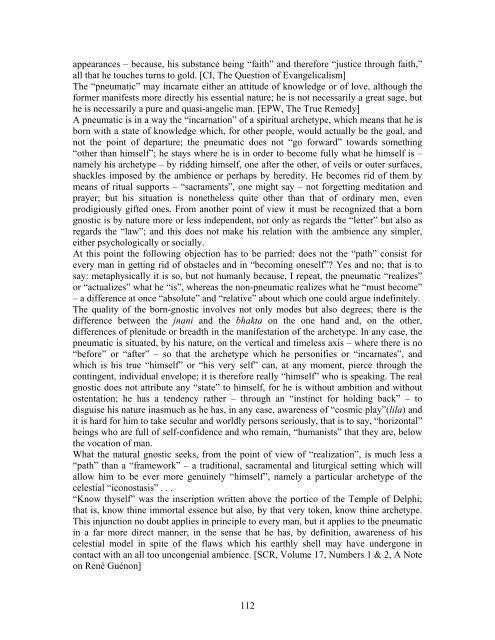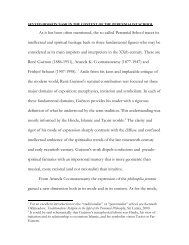glossary of terms used by frithjof schuon - Sophia Perennis
glossary of terms used by frithjof schuon - Sophia Perennis
glossary of terms used by frithjof schuon - Sophia Perennis
Create successful ePaper yourself
Turn your PDF publications into a flip-book with our unique Google optimized e-Paper software.
appearances – because, his substance being “faith” and therefore “justice through faith,”<br />
all that he touches turns to gold. [CI, The Question <strong>of</strong> Evangelicalism]<br />
The “pneumatic” may incarnate either an attitude <strong>of</strong> knowledge or <strong>of</strong> love, although the<br />
former manifests more directly his essential nature; he is not necessarily a great sage, but<br />
he is necessarily a pure and quasi-angelic man. [EPW, The True Remedy]<br />
A pneumatic is in a way the “incarnation” <strong>of</strong> a spiritual archetype, which means that he is<br />
born with a state <strong>of</strong> knowledge which, for other people, would actually be the goal, and<br />
not the point <strong>of</strong> departure; the pneumatic does not “go forward” towards something<br />
“other than himself”; he stays where he is in order to become fully what he himself is –<br />
namely his archetype – <strong>by</strong> ridding himself, one after the other, <strong>of</strong> veils or outer surfaces,<br />
shackles imposed <strong>by</strong> the ambience or perhaps <strong>by</strong> heredity. He becomes rid <strong>of</strong> them <strong>by</strong><br />
means <strong>of</strong> ritual supports – “sacraments”, one might say – not forgetting meditation and<br />
prayer; but his situation is nonetheless quite other than that <strong>of</strong> ordinary men, even<br />
prodigiously gifted ones. From another point <strong>of</strong> view it must be recognized that a born<br />
gnostic is <strong>by</strong> nature more or less independent, not only as regards the “letter” but also as<br />
regards the “law”; and this does not make his relation with the ambience any simpler,<br />
either psychologically or socially.<br />
At this point the following objection has to be parried: does not the “path” consist for<br />
every man in getting rid <strong>of</strong> obstacles and in “becoming oneself”? Yes and no; that is to<br />
say: metaphysically it is so, but not humanly because, I repeat, the pneumatic “realizes”<br />
or “actualizes” what he “is”, whereas the non-pneumatic realizes what he “must become”<br />
– a difference at once “absolute” and “relative” about which one could argue indefinitely.<br />
The quality <strong>of</strong> the born-gnostic involves not only modes but also degrees; there is the<br />
difference between the jnani and the bhakta on the one hand and, on the other,<br />
differences <strong>of</strong> plenitude or breadth in the manifestation <strong>of</strong> the archetype. In any case, the<br />
pneumatic is situated, <strong>by</strong> his nature, on the vertical and timeless axis – where there is no<br />
“before” or “after” – so that the archetype which he personifies or “incarnates”, and<br />
which is his true “himself” or “his very self” can, at any moment, pierce through the<br />
contingent, individual envelope; it is therefore really “himself” who is speaking. The real<br />
gnostic does not attribute any “state” to himself, for he is without ambition and without<br />
ostentation; he has a tendency rather – through an “instinct for holding back” – to<br />
disguise his nature inasmuch as he has, in any case, awareness <strong>of</strong> “cosmic play”(lila) and<br />
it is hard for him to take secular and worldly persons seriously, that is to say, “horizontal”<br />
beings who are full <strong>of</strong> self-confidence and who remain, “humanists” that they are, below<br />
the vocation <strong>of</strong> man.<br />
What the natural gnostic seeks, from the point <strong>of</strong> view <strong>of</strong> “realization”, is much less a<br />
“path” than a “framework” – a traditional, sacramental and liturgical setting which will<br />
allow him to be ever more genuinely “himself”, namely a particular archetype <strong>of</strong> the<br />
celestial “iconostasis” . . .<br />
“Know thyself” was the inscription written above the portico <strong>of</strong> the Temple <strong>of</strong> Delphi;<br />
that is, know thine immortal essence but also, <strong>by</strong> that very token, know thine archetype.<br />
This injunction no doubt applies in principle to every man, but it applies to the pneumatic<br />
in a far more direct manner, in the sense that he has, <strong>by</strong> definition, awareness <strong>of</strong> his<br />
celestial model in spite <strong>of</strong> the flaws which his earthly shell may have undergone in<br />
contact with an all too uncongenial ambience. [SCR, Volume 17, Numbers 1 & 2, A Note<br />
on René Guénon]<br />
112



